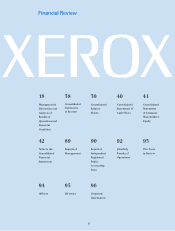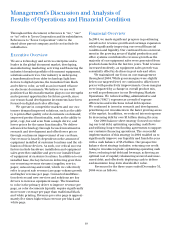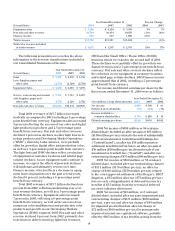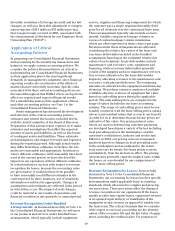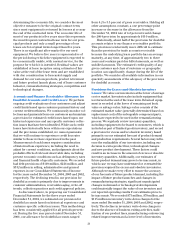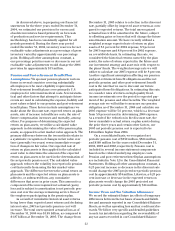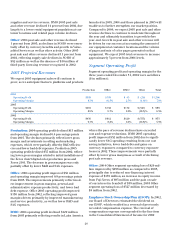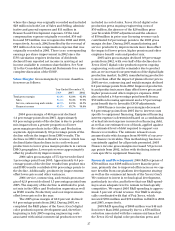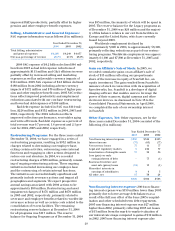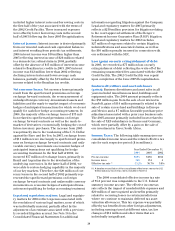Xerox 2004 Annual Report Download - page 22
Download and view the complete annual report
Please find page 22 of the 2004 Xerox annual report below. You can navigate through the pages in the report by either clicking on the pages listed below, or by using the keyword search tool below to find specific information within the annual report.
20
favorable resolution of a foreign tax audit and tax law
changes, as well as a favorable adjustment to compen-
sation expense of $31 million ($33 million pre-tax),
that was previously accrued in 2001, associated with
the reinstatement of dividends for our Employee Stock
Ownership Plan (“ESOP”).
Application of Critical
Accounting Policies
In preparing our Consolidated Financial Statements
and accounting for the underlying transactions and
balances, we apply various accounting policies. We
consider the policies discussed below as critical to
understanding our Consolidated Financial Statements,
as their application places the most significant
demands on management’s judgment, since financial
reporting results rely on estimates of the effects of
matters that are inherently uncertain. Specific risks
associated with these critical accounting policies are
discussed throughout this MD&A where such policies
affect our reported and expected financial results.
For a detailed discussion of the application of these
and other accounting policies, see Note 1 to the
Consolidated Financial Statements.
Senior management has discussed the development
and selection of the critical accounting policies,
estimates and related disclosures, included herein,
with the Audit Committee of the Board of Directors.
Preparation of this annual report requires us to make
estimates and assumptions that affect the reported
amount of assets and liabilities, as well as disclosure
of contingent assets and liabilities. These estimates
and assumptions also impact revenues and expenses
during the reporting period. Although actual results
may differ from those estimates, we believe the esti-
mates are reasonable and appropriate. In instances
where different estimates could reasonably have been
used in the current period, we have disclosed the
impact on our operations of these different estimates.
In certain instances, such as with respect to revenue
recognition for leases, because the accounting rules
are prescriptive, it would not have been possible
to have reasonably used different estimates in the
current period. In these instances, use of sensitivity
information would not be appropriate. Changes in
assumptions and estimates are reflected in the period
in which they occur. The impact of such changes
could be material to our results of operations and
financial condition in any quarterly or annual period.
Revenue Recognition Under Bundled
Arrangements: As discussed more fully in Note 1 to
the Consolidated Financial Statements, wesell most
of our products and services under bundled lease
arrangements, which typically include equipment,
service, supplies and financing components for which
the customer pays a single negotiated monthly fixed
price for all elements over the contractual lease term.
These arrangements typically also include an incre-
mental, variable component for page volumes in
excess of contractual page volume minimums,
which are often expressed in terms of price per page.
Revenues under these arrangements are allocated
considering the relative fair values of the lease and
non-lease deliverables included in the bundled
arrangement based upon the estimated relative fair
values of each element. Lease deliverables include
maintenance and executory costs, equipment and
financing, while non-lease deliverables generally
consist of the supplies and non-maintenance services.
Our revenue allocation for the lease deliverables
begins by allocating revenues to the maintenance and
executory costs plus profit thereon. The remaining
amounts are allocated to the equipment and financing
elements. We perform extensive analyses of available
verifiable objective evidence of equipment fair value
based on cash selling prices during the applicable
period. The cash selling prices are compared to the
range of values included in our lease accounting
systems. The range of cash selling prices must be rea-
sonably consistent with the lease selling prices, taking
into account residual values that accrue to our benefit,
in order for us to determine that such lease prices are
indicative of fair value. Our pricing interest rates,
which are used in determining customer payments,
are developed based upon a variety of factors including
local prevailing rates in the marketplace and the
customer’s credit history, industry and credit class.
Effectivein 2004, our pricing rates are reassessed
quarterly based on changes in local prevailing rates
in the marketplace and are adjusted to the extent
such rates vary by twenty-five basis points or more,
cumulatively, from the last rate in effect. The pricing
interest rates generally equal the implicit rates within
the leases, as corroborated by our comparisons of
cash to lease selling prices.
Revenue Recognition for Leases: As more fully
discussed in Note 1 to the Consolidated Financial
Statements, our accounting for leases involves specific
determinations under applicable lease accounting
standards which often involve complex and prescrip-
tive provisions. These provisions affect the timing of
revenue recognition for our equipment. If the leases
qualify as sales-type capital leases, equipment revenue
is recognized upon delivery or installation of the
equipment as sale revenue as opposed to ratably over
the lease term. The critical elements that we consider
with respect to our lease accounting are the determi-
nation of the economic life and the fair value of equip-
ment, including the residual value. For purposes of









